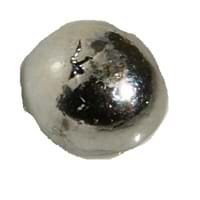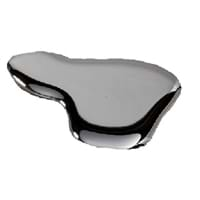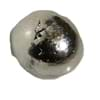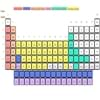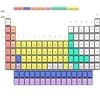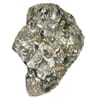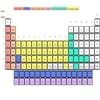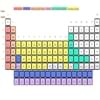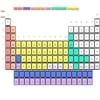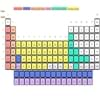Rhenium Mercury Comparison
Periodic Table
Symbol
Re
Hg
Group Number
7
11
12
6
Period Number
6
6
Block
d block
d block
Element Family
Transition Metal
Transition Metal
CAS Number
7440155
99+
7439976
99+
Space Group Name
P63/mmc
R_ 3m
Space Group Number
194.00
5
166.00
6
Facts
Interesting Facts
- Chemical properties of Rhenium are similar to Manganese.
- Rhenium metal is created while refining Molybdenum.
- At room temperature mercury is found in a liquid state.
- A coin of pound or rupees floats in mercury.
- Because of its low melting point and boiling point it is used in thermometers.
Sources
Found in Minerals, Mining, Ores of Minerals
Mining, Ores of Minerals
History
Who Discovered
Masataka Ogawa
Ancient Chinese and Indians
Discovery
In 1908
Before 2000 BCE
Abundance
Abundance In Universe
2 * 10-8 %
29
Not Available
Abundance In Sun
~0.00000001 %
29
~-9999 %
Abundance In Meteorites
0.00 %
99+
Not Available
Abundance In Earth's Crust
0.00 %
99+
0.05 %
9
Abundance In Oceans
0.00 %
34
Not Available
Uses
Uses & Benefits
- Alloys of Rhenium are used as an electric contact material. It can resist withstand arc corrosion.
- Its catalysts are used in hydrogenation of fine chemicals. Its Alloy with nickel is used to produce turbine blades.
- It is a liquid metal at room temperature, but it is a toxic heavy metal and hence many uses of mercury are under review or phased out.
- It is manly used as a catalysts in chemical industry.
Industrial Uses
Aerospace Industry, Automobile Industry, Chemical Industry, Electrical Industry, Electronic Industry
Electrical Industry, Electronic Industry
Medical Uses
NA
Dentistry
Other Uses
Alloys
Alloys, Mirror Manufacturing, Pharmaceutical Industry
Biological Properties
Toxicity
Low Toxic
Highly Toxic
Present in Human Body
No
Yes
In Blood
Not Available
0.01 Blood/mg dm-3
23
In Bone
Not Available
0.45 p.p.m.
19
Physical Properties
Melting Point
3,180.00 °C
2
Not Available
Boiling Point
5,627.00 °C
2
356.58 °C
99+
Appearance
Physical State
Solid
Liquid
Color
Silvery Gray
Silver
Luster
Metallic
NA
Hardness
Mohs Hardness
7.00
3
Not Available
Brinell Hardness
1,320.00 MPa
8
Not Available
Vickers Hardness
1,350.00 MPa
7
Not Available
Speed of Sound
4,700.00 m/s
15
1,451.40 m/s
99+
Optical Properties
Refractive Index
Not Available
1.00
3
Reflectivity
Not Available
73.00 %
8
Allotropes
No
No
α Allotropes
Not Available
Not Available
β Allotropes
Not Available
Not Available
γ Allotropes
Not Available
Not Available
Chemical Properties
Chemical Formula
Re
Hg
Isotopes
Known Isotopes
33
6
34
5
Electronegativity
Pauling Electronegativity
1.90
11
2.00
7
Sanderson Electronegativity
Not Available
2.20
7
Allred Rochow Electronegativity
1.46
15
1.44
17
Mulliken-Jaffe Electronegativity
Not Available
1.81
9
Allen Electronegativity
1.60
21
1.44
30
Electropositivity
Pauling Electropositivity
2.10
99+
2.00
99+
Ionization Energies
1st Energy Level
760.00 kJ/mol
20
1,007.10 kJ/mol
4
2nd Energy Level
1,260.00 kJ/mol
99+
1,810.00 kJ/mol
20
3rd Energy Level
2,510.00 kJ/mol
99+
3,300.00 kJ/mol
20
4th Energy Level
3,640.00 kJ/mol
99+
Not Available
Electrochemical Equivalent
0.99 g/amp-hr
99+
3.74 g/amp-hr
10
Electron Work Function
4.96 eV
7
4.49 eV
15
Other Chemical Properties
Corrosion, Ionization, Radioactive Isotopes, Solubility
Flammability, Ionization, Solubility
Atomic Properties
Atomic Number
75
99+
80
36
Electron Configuration
[Xe] 4f14 5d5 6s2
[Xe] 4f14 5d10 6s2
Crystal Structure
Hexagonal Close Packed (HCP)
Rhombohedral (RHO)
Crystal Lattice
BCC-Crystal-Structure-.jpg#100
RHO-Crystal-Structure-of-Mercury.jpg#100
Atom
Number of Protons
75
40
80
36
Number of Neutrons
111
26
121
22
Number of Electrons
75
40
80
36
Radius of an Atom
Atomic Radius
137.00 pm
40
151.00 pm
32
Covalent Radius
151.00 pm
34
132.00 pm
99+
Van der Waals Radius
200.00 pm
28
155.00 pm
99+
Atomic Weight
186.21 amu
36
200.59 amu
32
Atomic Volume
8.85 cm3/mol
99+
14.82 cm3/mol
35
Adjacent Atomic Numbers
Valence Electron Potential
180.00 (-eV)
3
28.20 (-eV)
99+
Lattice Constant
276.10 pm
99+
300.50 pm
99+
Lattice Angles
π/2, π/2, 2 π/3
NA
Lattice C/A Ratio
1.62
3
Not Available
Mechanical Properties
Density
Density At Room Temperature
21.02 g/cm3
12
13.53 g/cm3
24
Density When Liquid (at m.p.)
18.90 g/cm3
4
Not Available
Tensile Strength
1,070.00 MPa
3
Not Available
Viscosity
Not Available
0.00
1
Vapor Pressure
Vapor Pressure at 2000 K
0.00 (Pa)
29
Not Available
Elasticity properties
Shear Modulus
178.00 GPa
3
Not Available
Bulk Modulus
370.00 GPa
2
Not Available
Young's Modulus
463.00 GPa
2
Not Available
Poisson Ratio
0.30
14
Not Available
Other Mechanical Properties
Ductile, Malleable
NA
Magnetic Properties
Magnetic Characteristics
Specific Gravity
21.02
5
13.53
16
Magnetic Ordering
Paramagnetic
Diamagnetic
Electrical Properties
Electrical Property
Conductor
Conductor
Resistivity
193.00 nΩ·m
20
961.00 nΩ·m
1
Electrical Conductivity
0.05 106/cm Ω
33
0.01 106/cm Ω
99+
Electron Affinity
14.50 kJ/mol
35
0.00 kJ/mol
40
Thermal Properties
Specific Heat
0.13 J/(kg K)
39
0.14 J/(kg K)
38
Molar Heat Capacity
25.48 J/mol·K
38
27.98 J/mol·K
13
Thermal Conductivity
48.00 W/m·K
31
8.30 W/m·K
99+
Critical Temperature
Not Available
1,750.00 K
6
Thermal Expansion
6.20 µm/(m·K)
99+
60.40 µm/(m·K)
5
Enthalpy
Enthalpy of Vaporization
707.10 kJ/mol
3
56.90 kJ/mol
99+
Enthalpy of Fusion
33.05 kJ/mol
2
2.29 kJ/mol
99+
Enthalpy of Atomization
791.00 kJ/mol
2
61.50 kJ/mol
99+
Standard Molar Entropy
36.90 J/mol.K
99+
75.80 J/mol.K
6
|
||
|
||
|
